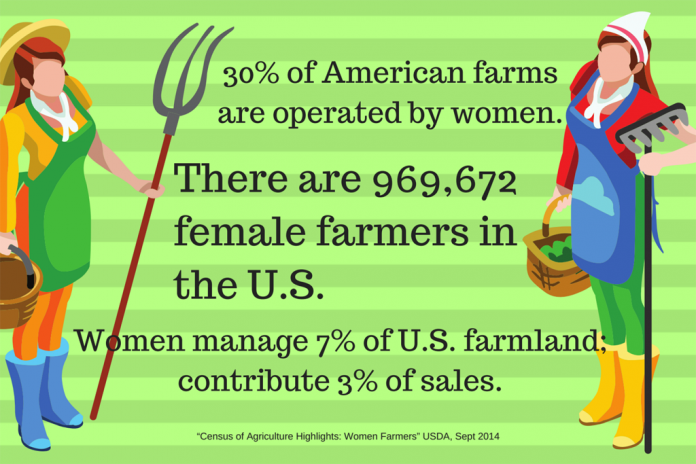My fondness for farming began when I was seven, the year my family moved from city to country. My mom grew up in small town US.A. Her childhood memories of riding horses and bottle-feeding lambs prompted the move. She wanted to give my siblings and me the same kind of upbringing in rural America.
At first I wasn’t happy about leaving my friends in the city. I also had a hard time memorizing and reciting the Pledge of Allegiance every morning before class; I had never heard the Pledge in my city school. But I quickly recognized country living had its benefits. Mom bought us horses, chickens, ducks and a dog. We grew a huge vegetable garden and a sizable strawberry patch. There were hills for sledding, woods to build forts in and wide open spaces to run free. Farm life eventually won me over.
My enthusiasm for all things rural eventually led to me starting to farm as an adult. My mom was the first agri-woman to mentor me, but certainly not my only inspiration. Strong farm women continue to support and motivate me to do the hard work of farming every day.
Why women farm
According to the most recent USDA Agricultural Census, there are 969,672 female farmers in the United States. Thirty percent of American farms are operated by women (2014).
Many of today’s women farmers grew up on a farm or in a rural community. Some are proud 4-H and FFA Alumni, whose positive experiences in those organizations encouraged them to pursue farming as a career. Like my mom, many women farmers tell me that they choose to farm because they see value in raising their kids in rural America, and want to instill an appreciation for Agriculture within.
Millennials are increasingly aware and concerned about food production. Many young women whom are new to farming say food system concerns fuel their desire to farm. Women beginning their farm journey are finding innovative ways to farm on less land, often in urban areas.
Women farmers are all ages, ethnicities and education levels. We come from diverse backgrounds and have different life experiences. Our strengths and weaknesses vary, but we all value hard work and are dedicated to feeding the future.
Off-farm work and women as primary and secondary operators
Annie’s Project is a non-profit organization dedicated to educating farm women in agribusiness operations, management, finances and decision making. The organization was named for Annie Kohlhagen Fleck, a farmer from Illinois.
Annie and her husband farmed together for 50 years. Her biography on the Annie’s Project website says, “Annie kept records. She kept the farm business running, she kept the family running, and she kept her marriage. Annie knew deadlines, reporting requirements, and tax issues. She did the little management jobs that supported big management decisions.” Read more about Annie’s Project.
At one point Annie’s husband worked a job in town while Annie managed the farm. This scenario is familiar to many of us who maintain an off-farm job while we farm, or have a spouse that works in-town to provide health insurance and other benefits for the family. The most recent Census of Agriculture reveals 57 percent of female farmers also work off-farm. Sixty-seven percent of secondary operators are women, often married to the principal farm operator (2012).
I see myself in Annie’s story. My spouse works in town to support our family while I work the farm. His nights and weekends are consumed with farm chores. Over the next year, he is transitioning to work full-time on the farm as I transition to a full-time corporate career. It’s a tough reality many farmers face, but something we are willing to do in order to live the dream.
Smaller farms, less sales
The majority of women-operated farms are small. Female farmers control just seven percent of farmland and account for three percent of agricultural sales. If there is one way we can encourage more women to farm it is to make it easier for women to find land and get products to market. Project Annie’s Education for Farm Women aims to do just that by providing teaching tools and resource linkage in 33 states. Find a class near you, http://www.anniesproject.org/upcoming-classes/.
Farm forward
Times changed dramatically during Annie’s 50 years farming, but the challenges of farming have not changed: Low profitability, new regulations, market trends and more. Annie was able to grow profitable farm business overtime by adapting to change and learning from others. It’s going to take a lot of female farmers to feed the future. We will get there faster if we do it together and help one another along the way.
Resources
- Annie’s Project Homepage, Accessed Feb 11, 2017 from http://www.anniesproject.org/
- “Census of Agriculture 2012”, USDA, Accessed Feb 11, 2017 from https://www.agcensus.usda.gov/Publications/2012/
- “Census of Agriculture Highlights: Women Farmers” USDA, Sept 2014, Accessed Feb 11, 2017 from https://www.agcensus.usda.gov/Publications/2012/Online_Resources/Highlights/Women_Farmers/Highlights_Women_Farmers.pdf












